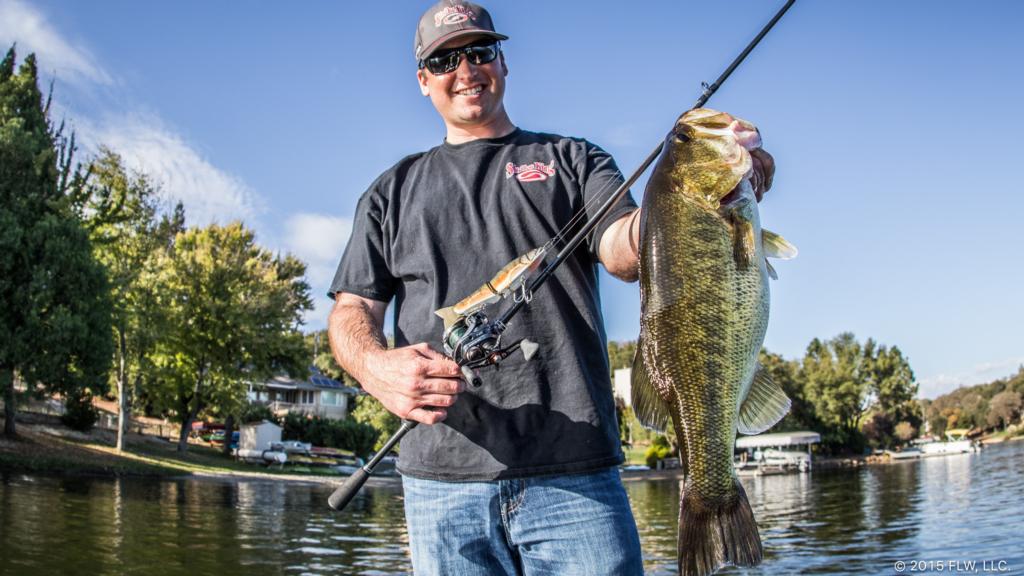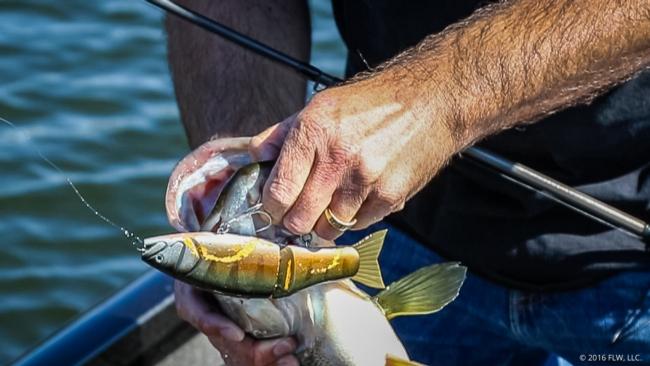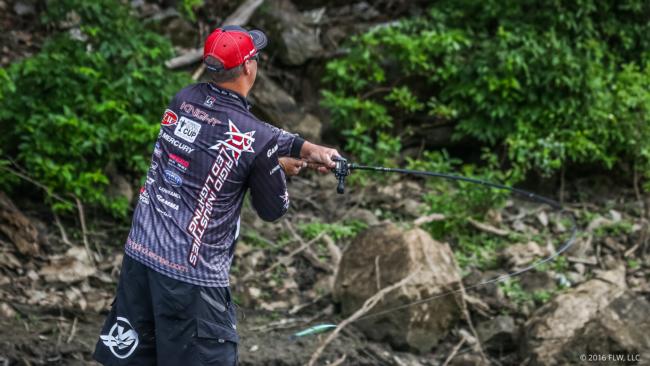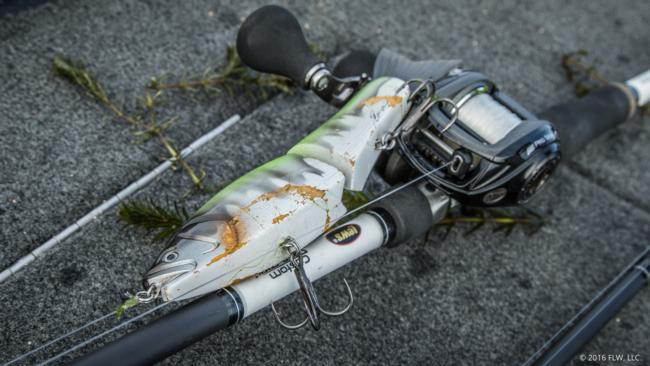Meyer and Knight Break Down Glide Baits
How two of FLW’s best apply the hottest swimbaits going

While soft-plastic swimbaits have been tearing it up in tournaments back East for a while, outside of the Bull Shad there haven’t been too many hard swimbaits that have made a mark. That might change soon – glide baits are becoming more popular and can be a dynamite option in almost any season other than winter.
Glide bait basics are simple: They’re all made with a single joint in the middle, most of them are fairly large and each has a pair of treble hooks. Designed to swim in a lazy “S” curve on the retrieve, most glide baits are available in floating and slow-sink models with the occasional fast-sink thrown in. Ideal for targeting big fish fairly shallow in clear to moderately stained water, they’re catching fish all over the country now. Some of the more popular models are the Hinkle Shad (there’s a waiting list for these guys), Deps Slide Swimmer, the moderately priced River2Sea S-Waver and the Roman Made Negotiator.
That covers the basics, but there’s a lot more to using these lures successfully. Who better to go into the details than two of the best swimbait flingers on Tour: Cody Meyer and Brad Knight.
Meyer glides to find
Born and raised in the West, Meyer isn’t shy when it comes to breaking out glide bait. Though he’ll use them to catch plenty of fish, the California pro uses big glide baits more as fish finders.
“I like to cover water with them until I find fish and then really pick it [the area] apart,” confesses Meyer. “Because big fish are so drawn to the bait, I like to fish it to draw them out. A lot of times I won’t actually catch them with the swimbait, but I’ll find out where they’re living and come back with a drop-shot rig or a Senko and pick them off.”
Meyer’s favorite conditions for glide baits are the standard swimbait scenario of clear water with a little wind. His favorite places are weed flats and edges, points, laydowns and manmade shade such as docks and buoy lines.
Triggering bites
The trick that sets Meyer apart from the competition is his unique retrieve.
“You’ll get a lot of followers with a glide bait, but it can be hard to get them to bite. What I like to do is really take my time and pop it and work it side to side and back and forth, almost like you’re fishing a fluke. You’ll get a lot of fish that will follow it up, and you catch a lot more of them when you’re popping it and working it.”
Instead of waiting to give the bait extra action when he see’s a follower, Meyer will give the bait action all the way in to try and trigger a bite at any point in the cast. If he does have a bass follow it up, an extra hard pop of the rod will let the bait glide around nearly 180-degrees and into the face of a following lunker.
Braid and a leader
Meyer’s tackle isn’t as outsized as you might imagine it should be to handle a heavy glide bait. He’s likely to throw them using a Daiwa Zillion TWS with 6.3:1 gear ratio matched with a 7-4, heavy-power, Daiwa Steez XBD Frog Rod. On the line side, Meyer prefers 50-pound-test Seaguar Smackdown Braid with a leader of about 20 feet long. His choice here is 20-pound-test Seaguar Tatsu Fluorocarbon so he has a low-stretch, nearly invisible connection to pop the bait easily.
Using braid as the main line complicates things a bit, but it allows Meyer to work the bait in the manner he wants.
“You don’t really need a hookset with braid. You can just load into them,” explains the California pro. “Also, you don’t want to whip the cast hard with braid or you can snap off. Just lobbing it will work fine.”
How Knight glides
Known for his prowess with a swimbait, Brad Knight has learned how to apply a glide bait in the highland lakes of east Tennessee.
“The main thing that drew me to it was how many fish I was seeing with it,” explains Knight, the 2015 Forrest Wood Cup champion. “It seems to trigger something in the fishes’ curiosity that most baits don’t – almost like an umbrella rig.”
Knight’s knowledge is hard-won and has resulted in some high tournament finishes. Not surprisingly, he was happy to provide some tips for glide baits, but wasn’t about to spill the beans regarding all the best situations to fish them.
“I vary my retrieve up a bunch,” explains Knight. “Glide baits are very versatile that way, but it’s not like a crankbait where you’re just throwing it out and winding it in; it needs to be manipulated.
“Most every cast I make I add some kind of variance to try and catch followers. The main thing is to let the bait work itself, not overwork it. It’s made to glide, and using the reel handle to twitch it is enough.”
Knight doesn’t have one magic retrieve like Meyer. His favorites are a straight retrieve with a few stops (perhaps three or four pauses in a cast) or a slow and steady retrieve with two or three quick turns of the reel handle at staggered intervals.
Though Knight usually starts a tournament day with a midsized glide bait, he likes to fish the truly giant ones from time to time.
“Everything is just on a grander scale [with the bigger baits]. Compared to the Negotiator, the Mother (Roman Made’s 12-inch glider) just moves more water and has a much wider glide. On the curve, once it turns and goes to the right it goes to the right more than a foot farther than the Negotiator does.”
Knight’s tackle preferences
As for the bait itself, Knight prefers one that sinks horizontally – not head or tail first – at a medium rate. For the action, the Tennessee pro wants one that has a smooth glide and turns “gracefully” instead of cutting at an angle when it reaches the outside of its glide.
“A Hinkle is a good example,” says Knight. “It’s hard to find, but that’s one that has a really nice slow glide. That natural glide really amps up the drawing power of the bait.”
Though color can be key for a lot of lures, Knight believes it doesn’t make much difference on a glide bait. Though he doesn’t throw solid pink-colored ones and is partial to some custom-foiled finishes, there isn’t one go-to color he relies on almost exclusively.
To throw glide baits, Knight recommends a Lew’s BB2 Inshore Speed Spool with a 7.1:1 gear ratio paired with 20- to 25-pound-test Gamma Edge Fluorocarbon. For the rod, the Tennessee pro chooses an 8-foot Lew’s Custom Speed Stick Magnum Swimbait rod for larger baits and a 7-11 extra-heavy-power Lew’s Custom Speed Stick Magnum for the smaller ones.
Just do it
However you fish it, a glide bait can alternately produce heartbreaks or eye-popping results like no other bait.
“The hardest thing with a swimbait is when to put it down,” advises Knight. “It’s like a drug – one day it can be hot as freakin’ fire; another day you can’t seem to even see a fish, and the next day you’ll have a hundred just follow it.”


